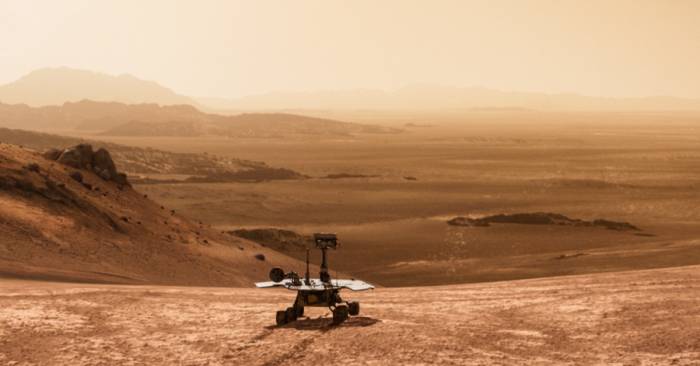When we watch various documentaries about the natural environment of the Earth, we should often observe a phenomenon where small animals frequently cling to or attach themselves to the bodies of larger animals, using this hitchhiking method for migration and predation.
Coincidentally, this situation is not only found on Earth but also on extraterrestrial planets, after all, who wouldn't want to take a shortcut? Only the object of the hitchhike has become the probes we launch to extraterrestrial planets.
On the desolate Mars, the rover's tracks left by the probe are visible.
NASA's Perseverance rover on Mars has encountered such a problem, with a Martian rock having accompanied it for over a year.
However, according to the latest updates on the Perseverance rover released by NASA in the middle of this month, the "pet rock" that hitched a ride with Perseverance for more than a year has finally disembarked, and Perseverance has returned to its carefree days without a stone, although it is unknown whether Perseverance will remember its "it" when it retracts its solar sails at night.
Advertisement
A close-up of the rock stuck in its left front wheel taken by Perseverance.
The control team of the Perseverance rover probe was very disapproving of this Martian rock that joined them halfway, and they have been trying to find ways to get rid of it.
But it stayed on the left front wheel of Perseverance for over a year, and the scientists executing the Perseverance rover mission at NASA described it as "like a pebble in a shoe," showing their disapproval of this unwanted companionship.
Finally, this month, NASA got what they wished for; after more than a year of cohabitation on the red planet, they have finally parted ways.
Perseverance, alone in its mission to explore and sample on Mars.The Perseverance rover's left front wheel unexpectedly picked up this Martian rock on February 4, 2022, or Sol 341, which was the 341st Martian day of the rover's mission on Mars.
Initially, scientists of the Perseverance mission thought that the Martian rock would fall off after the rover had moved a few wheel distances forward, but the reality did not unfold as they had predicted. Even after several aggressive maneuvers on the Martian surface, the situation remained unchanged.
In the end, scientists back on Earth had no better solutions to prevent the close contact between them and could only take regular photographs to check. After confirming that the rock did not pose a significant threat to the scientific mission of the Perseverance rover, they let it be.
On April 18, a close-up high-definition image of the empty left front wheel was taken.
Finally, by mid-April (Sol 768), NASA released a photo of the left front wheel of the Perseverance Mars rover, showing that the Martian rock had finally fallen off.
Overall, this Martian rock remained in the wheel of the Perseverance rover for about 439 days, which is approximately 55% of the time the rover has spent on Mars since landing on February 18, 2021.
During this period, they traveled together for about 10 kilometers.
In fact, during the mission, the other wheels of the Perseverance rover have also picked up several smaller rocks, but none have stayed for more than a year like this rock.
Those small rocks would fall off within days or weeks after getting stuck as the rover continued to move forward, posing no threat to the rover. Of course, there have been instances where Martian debris from other locations has caused safety issues for the rover.Previously, the Mars rover Spirit

In December 2021, a cluster of small pebbles was picked up and fell into the mechanical structure of the Perseverance rover, causing the Mars rover to be immobilized for nearly a week before mission scientists devised a method to safely remove them.
These hitchhiking rocks have also caused problems for other Mars rovers. In December 2004, less than a year after arriving on Mars, the Spirit rover was stuck by a potato-sized stone, and the operators at the time had to make a sharp turn to shake it out from the right rear wheel.
China's Zhurong Mars rover
Learning from NASA's experiences, to guard against similar issues, our Zhurong Mars rover has also been specifically improved with anti-clogging wheel design. The rover's wheels feature some sieve holes, and all four wheels can drive in different directions to avoid the problem of getting stuck by rocks.
Comments